Steps for Installing LED Strip Lights on Stairs
Table of Contents
Regarding stair lighting, LED strip lights blend modernity and elegance. I was wondering how to mount them. LED strips’ adaptability and customizable nature offer endless possibilities for stair installation. Whether you’re looking to place them on individual steps, along the side of the treads, or even on the walls or ceiling adjacent to the staircase, the choices are myriad. Most of these strips come with an adhesive backing, simplifying the installation. However, alternatives like clips or aluminum channels can also be explored.
You’ve landed in the right spot if you aim to introduce LED strips to your stairway. This piece provides a comprehensive guide on how to affix LED strips to stairs, select the perfect ribbon, maintain them, and more. Let’s dive in.
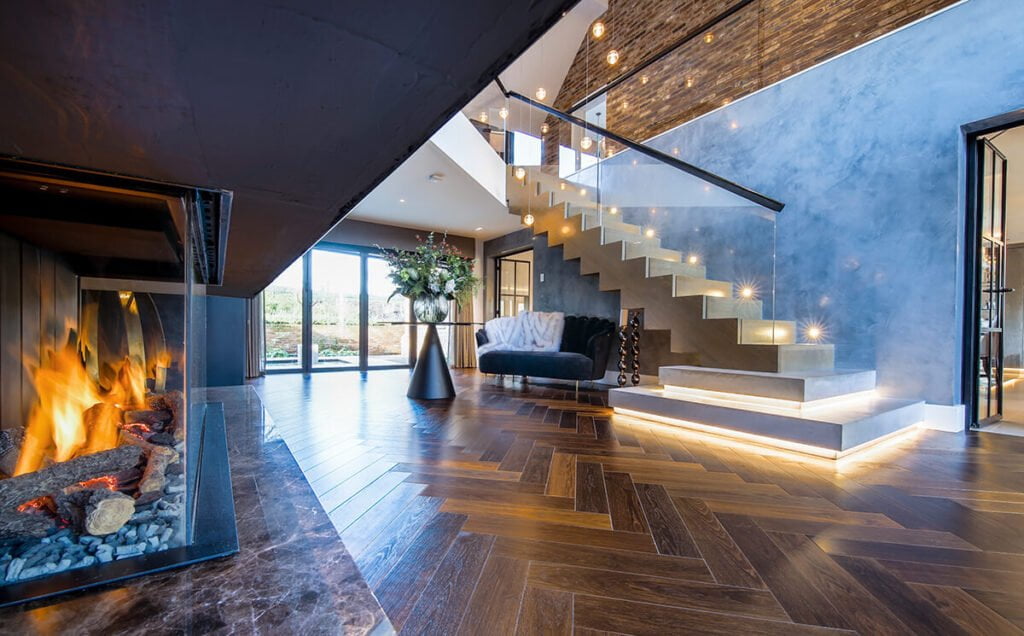
What Exactly Is Stairway Lighting?
Stairway lighting revolves around illuminating the staircase with diverse lighting fixtures. It primarily enhances visibility, ensures safe navigation, and prevents potential mishaps on the stairs. Improved visibility also uplifts the overall aesthetics of the staircase.
A staircase comprises various components, including the tread, riser, railings, landing, and nosing. When you strategize lighting for all these areas, it can transform the ambiance of the entire stairway. While multiple lighting options are available, such as spotlights, recessed lights, and even grand chandeliers for larger stairwells, LED strips are the go-to choice for many. This article delves into the nuances of employing the current favorite in stair lighting – the LED strip lights.
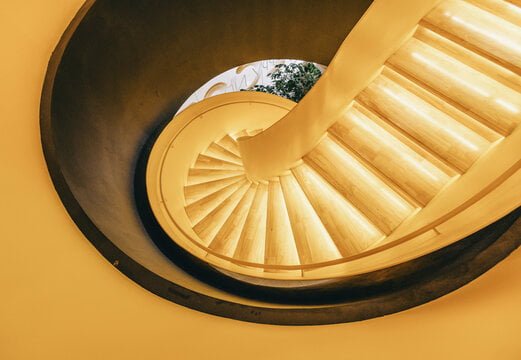
Advantages of Installing LED Strip Lights on Stairs
Installing LED strip lights on stairs offers several advantages in terms of aesthetics and functionality. Here are some of the key benefits:
- Safety Enhancement:
- LED strip lights illuminate each step, reducing the risk of tripping or missing a step in the dark.
- They provide gentle and even lighting, which can be especially beneficial for seniors, children, and pets.
- Energy Efficiency:
- LED lights consume less electricity than traditional incandescent or halogen bulbs, making them an energy-efficient choice.
- They have a longer lifespan, requiring less frequent replacement, leading to cost savings in the long run.
- Ambiance and Aesthetics:
- LED strip lights can enhance the overall look of a staircase, adding a touch of modern elegance.
- They are available in various colors, allowing for personalized decorative effects. Some even offer color-changing options to match moods or events.
- Flexibility:
- LED strips are flexible and can be customized to fit any staircase design, whether straight, spiral, or curved.
- Depending on the desired effect, they can be installed on the sides, under the steps, or along handrails.
- Low Heat Emission:
- Unlike some traditional lighting options, LED strip lights emit very little heat, reducing the risk of burns or fire hazards.
- Easy Installation and Maintenance:
- Many LED strip light kits come with adhesive backings or mounting brackets, making installation straightforward for DIY enthusiasts.
- They are generally low-maintenance, with no bulbs to replace or complicated wiring to troubleshoot.
- Dimmability:
- Some LED strip lights come with dimming features, allowing homeowners to adjust the brightness level to their liking, whether they want soft mood lighting or brighter illumination.
- Motion Sensing Capabilities:
- Some advanced LED strip light setups come with motion sensors, which means the lights turn on when someone approaches and turn off when no movement is detected. This further enhances energy efficiency and convenience.
- Environmental Benefits:
- LED lights are mercury-free and produce fewer greenhouse gas emissions than traditional bulbs, making them more environmentally friendly.
- Cost-effective:
- While the initial investment might be higher than other lighting options, the long lifespan and energy savings of LED strip lights often make them cost-effective.
Why Opt for LED Strips in Stairway Lighting?
What makes LED strips stand out in the sea of stairway lighting options? Simply put, LED strip lights impart an enchanting glow to stairways. Their flexibility means they can be molded and placed in various stair sections, achieving your desired lighting aesthetic. But that’s not all – there are numerous reasons why LED strips are the go-to choice:
Energy Efficiency
LED strips are champions of energy conservation. Their LED technology ensures they consume about 85% less energy than conventional lighting like incandescent bulbs. This makes them perfect for illuminating stairs in homes and businesses without causing a surge in electricity bills. Additionally, they don’t overheat or release harmful substances such as mercury, positioning them as eco-friendly light solutions.
Cutting-Edge Features
Transform mundane staircases with LED strips. They come equipped with features like color transitions and brightness controls, allowing you to set the tone of your stairway based on the occasion. A cozy family dinner? Warm, yellow-hued lighting would be apt. Are you hosting a lively party? Switch to vibrant red or blue using RGB strips. To truly elevate this experience, consider motion-sensor LED strips that will astonish every guest with each step they take.
Highly Customizable
When it comes to tailor-made stairway lighting, LED strips are unrivaled. They can be trimmed to fit the exact size of your staircase and be positioned precisely where you envision. Moreover, there are options to modify their voltage, energy usage, IP ratings, and more. For top-tier customization, consider MylikeLed, known for its adaptability, ODM, and OEM capabilities.
Perfect for All Staircases
Whether indoors or outdoors, LED strips cater to all stair lighting needs. Their diverse IP ratings mean they’re suitable for both environments. Lower IP-rated strips are perfect for interiors, while higher ratings ensure protection against harsh weather elements like rain or wind. These strips are also shock and corrosion-resistant, making them ideal for any stair type. Being cool to the touch, they’re a brilliant option for inventive lighting designs.
Hassle-Free Installation
The adhesive backing on LED strips guarantees a smooth installation process. Just cleanse the stairs, pinpoint the desired area, peel the adhesive layer, and affix the strip – it’s that straightforward! For added security, especially outdoors, consider clips or aluminum channels. The best part? No need for a professional – installation is a breeze.
Sleek Appearance
LED strips are the answer to infusing modern flair into your stairway. Their concealed lighting crafts an elegant aura for any staircase. Incorporating these lights in residential stairs amplifies interior elegance, while commercial spaces, like eateries or hotels, benefit from the added appeal. It’s an effective way to draw in those seeking the perfect photo opportunity, serving as an ingenious promotional tool.
Guide to Selecting LED Strips for Stair Lighting
Before adding LED strips to your stair lighting, remember crucial points. Here’s what you need to know to make the right choice:
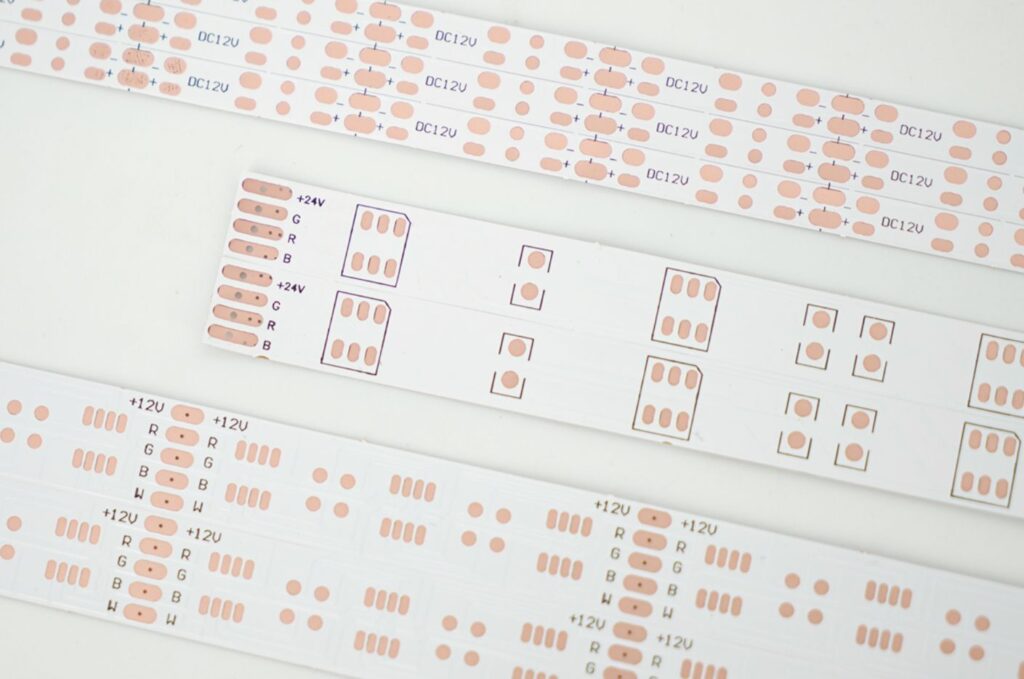
Categories of LED Strips
LED strips come in various styles, differing in brightness and color. The top picks for stair lighting are:
a. Single Color LED Strips
If simplicity is what you’re after, the single-color LED strip is for you. It offers a straightforward lighting solution and can be tailored to voltage and wattage to achieve the desired brightness.
b. Adjustable White LED Strips
These are the pinnacle of versatility in white lighting. Adjust the ambiance of your stairway with ease by moving from warm to cool white tones. Do you desire more astonishing lighting? Crank up the color temperature. Need a warmer feel? Dial it down.
c. Warm-Tone LED Strips
For homes bathed in warm lighting, these strips are a perfect fit. They provide various warm shades, from golden to deep orange, perfect for creating a snug feel. They’re also ideal for restaurants aiming for a cozy dining experience.
d. RGB LED Strips
Are you looking to infuse your stairs with color? RGB LED strips are your go-to. With 3-in-1 chips, they can produce 16 million colors using red, green, and blue. They’re perfect for those wanting vibrant stair lighting.
e. Motion-Sensing LED Strips
These are the trendsetters in stair lighting. They lend a futuristic touch to your stairs by illuminating them upon detecting motion. If your home embraces innovative technology, these strips are a match made in heaven.
Remember, choosing the right LED strip can transform your stairway, enhancing its aesthetic appeal and ensuring safety. Choose wisely!
Color Tone
The LED strips’ color temperature dictates the shade of the light emitted. For a cozy, warm hue in your stairway, opt for LEDs with a reduced color temperature, producing a golden to amber glow. For a crisper, more relaxed vibe, go for LEDs with elevated color temperatures. If you seek flexibility, consider tunable or dim-to-warm LED strips for adjustable color tones.
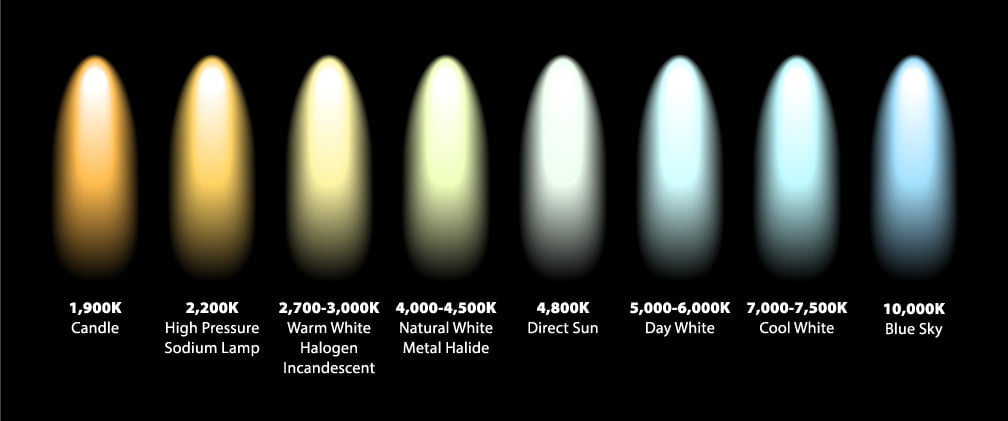
| Color Tone | Color Temperature |
| Warm Tone | 2700K and 3000K |
| Cool Tone | 3500K and 4100K |
| Daylight | 5000K and 6500K |
Luminosity
Lumen measures the brightness of your light source. A higher lumen count means a brighter output. Determine the luminosity you desire for your stairway illumination before choosing the appropriate LED strips. Overly optimistic options might elevate both your purchase and energy expenses.
Strip Length
LED strips typically come in reels of 5 meters. However, variations exist, with some spins stretching up to 60 meters depending on their voltage specifications. For bespoke strip lengths, reach out to MylikeLed.
LED Concentration
LED density plays a pivotal role in your selection. It shapes the overall illumination effect. Opting for sparsely packed LEDs might yield visible dots, which some might find unattractive. Choose LED strips with a higher LED concentration for a consistent, seamless glow. Personal preferences vary; some might appreciate the dotted effect. Yet, be aware that as LED density rises, so does the price of the strip.
Voltage Considerations
LED strip lights typically come in two primary voltage options: 12V and 24V. One key consideration is that extending the LED strip by connecting multiple sections has a potential for voltage drop, which can reduce light output. While it’s possible to address this with extra wiring, it can complicate the installation. That’s why LED strips like the Constant Current series, which offer higher voltage ratings, are perfect for extensive stair lighting. Their voltage specifications are:
- 48Vdc for 50 meters
- 36Vdc for 30 meters
- 24Vdc for 20 meters
When these strips are installed, they ensure consistent brightness without any noticeable voltage drop. Additionally, high-voltage, driverless AC LED strips are available that can offer voltages such as AC110V, AC120V, AC230V, and AC240V.
IP Rating
The IP (Ingress Protection) rating is pivotal when buying LED strips. This rating differs based on where you intend to use the LED strip, indoors or outdoors. The IP rating indicates the protection level against dust and moisture ingress. For indoor stair applications, a rating of IP20 or higher should suffice. Consider a more robust IP rating for outdoor stair setups like IP44, IP65, or even higher.
However, it’s essential not to over-specify. Purchasing an LED strip with an excessively high IP rating for your needs can lead to unnecessary costs. Continually assess the environment where you’ll be using the ribbon. For instance, the IP68 rating for poolside stairs is ideal, as it ensures total water resistance, even submersion. Yet, such high protection isn’t needed for indoor residential stairs.
Redefining Control
Manipulate LED strip lights with a variety of methods using the LED controller. Choices range from a straightforward switch controller to a remote-control system. Modern LED strip lights even integrate mobile control capabilities. This means you can effortlessly modify your stair lighting via your smartphone. Also, it’s noteworthy to mention motion-sensor LED strips that operate autonomously, eliminating the need for manual on/off toggles.
Tailored Solutions
Pre-made LED strips might not align with your desired lighting specifications. If that’s the case, seek out manufacturers that provide bespoke solutions. Reach out to MylikeLed; we cater to your needs, from power consumption and voltage to IP rating, length, LED density, and beyond.
Assured Quality through Warranty
The warranty on LED strips can often be a reflection of their quality. Prioritize LED strips backed by solid warranty terms. Our LED strips come with a warranty spanning three to five years. We’re here to assist if you encounter any complications within this period.
LED Strip Installation for Stairs
Setting up LED strips on stairs is both fast and straightforward. Expertise in electrical work isn’t necessary. Below is a detailed guide to assist in fitting LED strips on your staircase:
Installing LED Strips on Your Stairs: A Step-by-Step Guide
1. Picking the Perfect LED Strip
Begin by selecting the appropriate LED strip for your stairs. Consider indoor versus outdoor use, desired brightness, strip length, and voltage. The previous guide will aid in making the best choice.
2. Decide on the Placement
Determine where the LED strips will go: ceiling, railings, individual steps, or treads. After selecting, ensure the chosen spot is wiped clean with a damp cloth to remove dust and dirt. A clean surface provides better adhesion.
3. Measure and Trim the LED Strip
After cleaning, measure the required length using a tape. For example, if placing strips beneath each step, measure that step’s length. Trim the ribbon at the indicated cut marks using scissors. Did you make an error? Don’t worry; LED strip connectors can reconnect them.
4. Ensure Correct Polarity
Once the strips are trimmed, align them with connectors and wiring, ensuring the correct polarity. The positive and negative markings must align. Proper polarity is crucial; otherwise, the LEDs won’t illuminate.
5. Making Connections
Once polarity is set, connect components, including dimmers and power sources, using soldering. Alternatively, LED connectors offer a faster connection method. For outdoor installations, soldering provides a sturdier link.
6. Check Your Work
Before finalizing installation, test the LED strip to verify the correct wiring. Power it up, and if it doesn’t light, recheck connections and polarity. Always test before permanent installation to avoid wasted effort.
7. Adhere to the LED Strips
Position the LED strips where desired, peel off the adhesive backing, and firmly press them in place. While the inbuilt 3M tape is vital, you can affix clips and screws for added security.
8. Power Up and Admire
Switch on the power with the LED strips in place and wired correctly. Revel in the glow of your illuminated stairs!
Remember, while these steps make the process seem simple, consider hiring a professional electrician for optimal safety and results if installing outdoor lighting.
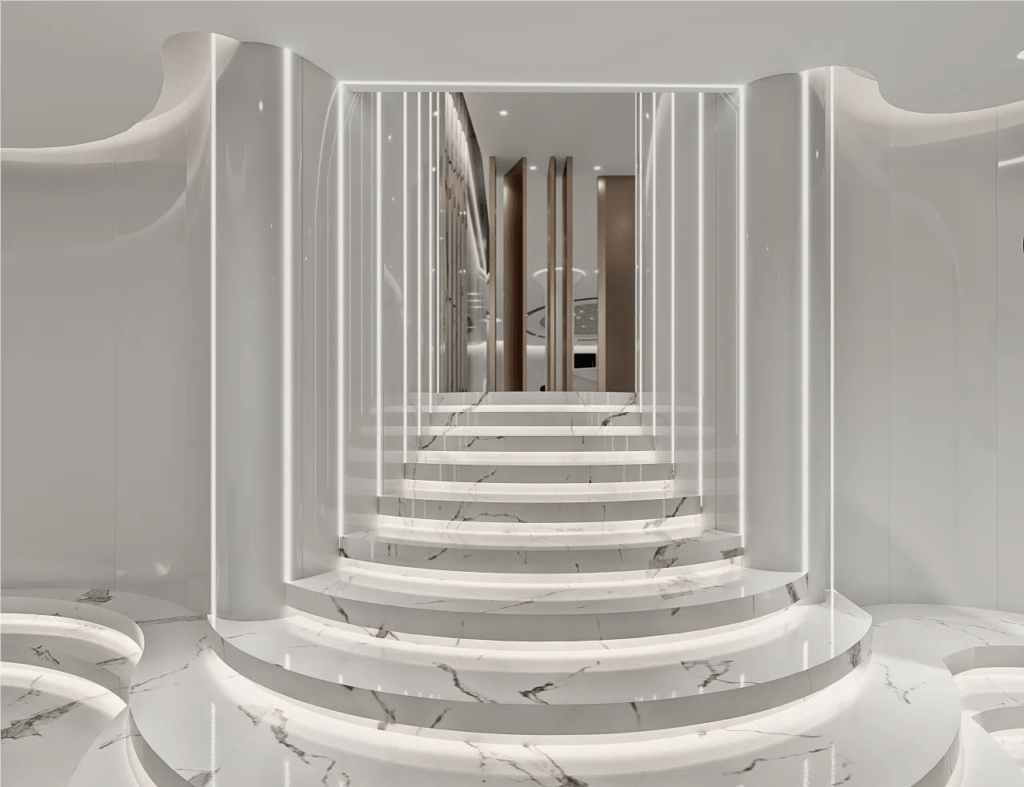
Optimal LED Strip Placement for Stairs
I wondered about the best spots to position LED strips on your staircase. The adaptability of LED strips offers countless possibilities for installation. Here are some recommendations for strategic placements. Remember, these are just suggestions, and there’s an entire universe of creative options waiting for you:
- Stairway Ceiling: Add LED strips to your stairs, especially for multi-level stairs like duplex or triplex styles. By introducing a false ceiling, you can seamlessly incorporate LED strips for a concealed lighting look, providing overall illumination for the staircase.
- Beneath Each Tread: There’s typically room to position LED strips under every stair tread. This lights up each step and adds an elegant touch to the entire staircase.
- Side of the Tread: If your staircase lacks sidewalls or has at least one open side, positioning LED strips along the tread’s side can be an excellent choice. This emphasizes the stairs’ side profiles and offers visibility from afar.
- Center of Each Step: For a unique touch, think about placing LED strips right at the center of each step. While running the strip along the entire stage is common, strategically placing it in the center with spaces on either side can offer a distinct look.
- Below Wall Grooves or Lips: If your stairs feature a groove or lip design, placing the LED strips beneath them can accentuate these details.
- Under the Handrail: Given the safety features of LED strips, like being shock-proof, cool to touch, and operating on low voltage, they’re ideally suited for Placement underneath stair railings.
While these suggestions can guide your LED strip installation, let your creativity be the driving force. The potential for innovative lighting solutions is limitless!
Methods for Attaching LED Strips to Staircases
Consider the following techniques for affixing LED strips to stairs, selecting the one that aligns best with your preferences:
- Adhesive-Backed Tapes
Most LED strip lights have 3M adhesive tapes on the back. This feature simplifies the installation, making it so straightforward that even kids can handle it. To install, peel off the protective layer and firmly press the strip onto the staircase.
- Clip Attachments
Another avenue for setting up LED strips involves the use of clips. You can choose from various materials, like plastic or metal. Some prevalent types of LED strip clips are:
- Single-side bracket clips
- Adjustable-angle clips
- Clips equipped with adhesive
- E-Clips
It’s important to note that if you opt for certain clip types, drilling into the stairs might be necessary, which could lead to irreversible damage. However, adhesive-backed clips offer a no-drill solution.
- Aluminum Channels
Considering the regular impact and traffic staircases endure, utilizing aluminum channels can be an effective method for LED strip installation. Available in diverse styles, these channels are designed to complement your staircase lighting needs.
- Surface Mounting Channels
Surface mounting channels represent the simplest type of aluminum channels used for LED strip installations. They’re perfect for placing LED strips on flat stair surfaces or between steps.
- Inset Mounting Channels
Inset mounting channels are the top pick if you’re aiming for integrated stair lighting. Remember, for this setup, it’s crucial to install the channels during the staircase construction phase.
- Diagonal Mounting Channels
Consider positioning the lights diagonally to illuminate specific areas of stairs, like beneath the tread or any corner. Diagonal mounting channels are optimal for attaching LED strips in these situations.
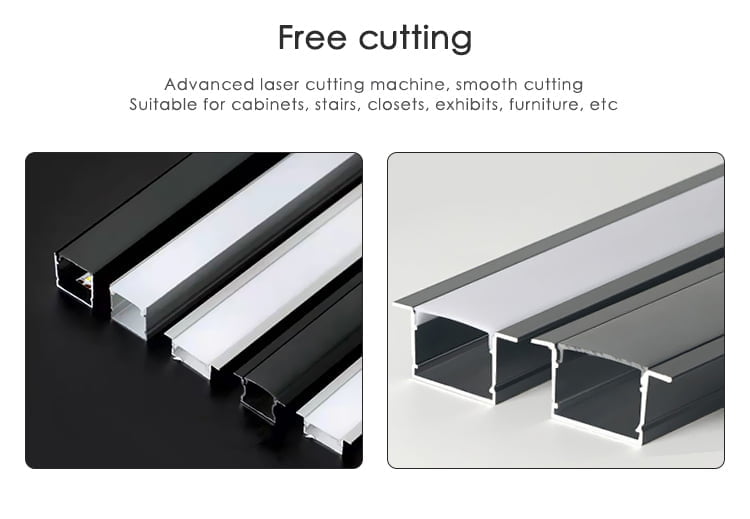
Guide to Maintaining LED Stairway Lights
Although LED strip lights require minimal upkeep, routine care can significantly enhance their lifespan. For those using LED strips for stairway illumination, here are essential maintenance steps to consider:
- Regular Cleaning: Given the constant foot traffic on stairs, LED strips are bound to collect dirt over time. Such land can impede the spread of light. Concurrent dust can harm the fixtures, particularly for strips with lower IP ratings. Regularly clean the stripes, but avoid wet cleaning unless they are water-resistant.
- Monitor Voltage: If you’ve extended the length of your LED strips along the stairs, they might experience voltage drops. Observe the brightness levels; if the light dims progressively, it’s best to consult an electrician.
- Use Judiciously: To prolong the lifespan of LED strips and to save on energy bills, turn them off when they’re not essential. Activate them during nighttime or when hosting guests.
Innovative Stairway Lighting Using LED Strips
Venture beyond traditional lighting methods with LED strips. Here are some inventive ways to illuminate your stairway:
- Dynamic Wall Patterns: Enhance the appeal of your stairs by creating captivating patterns on the adjoining walls. Utilizing recessed mount aluminum channels can achieve the envisioned design.
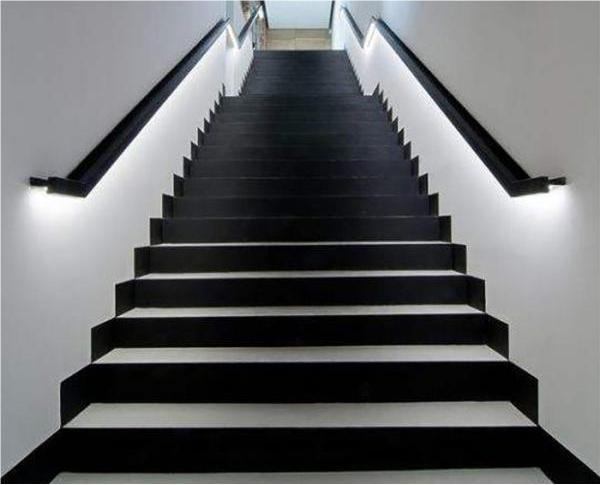
- Vibrant LED Strips: Ditch the standard white LED strips for RGB variants to add color to your staircase. Consider crafting a rainbow-themed staircase or merging various colored stripes for a gradient effect.
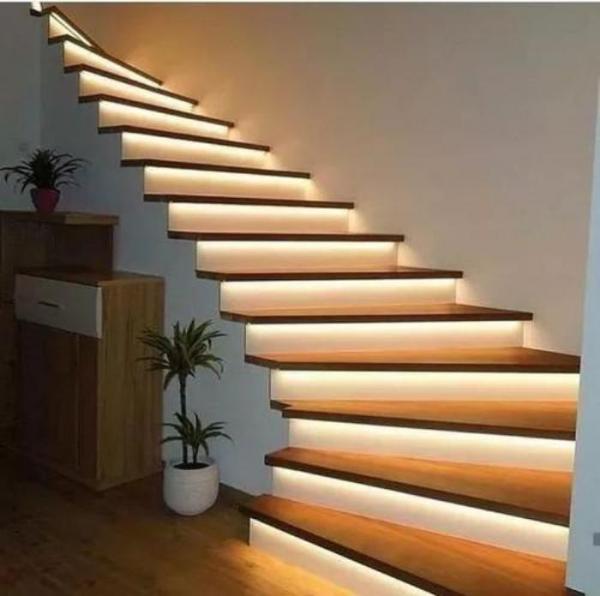
- Subtle Lighting Touch: Impart a refined, indirect lighting charm to your stairs using LED strips. Ceiling cove lighting or strips beneath the steps can produce this elegant glow. Attaching the strips to the base of every step for open riser staircases promises an astonishing outcome.
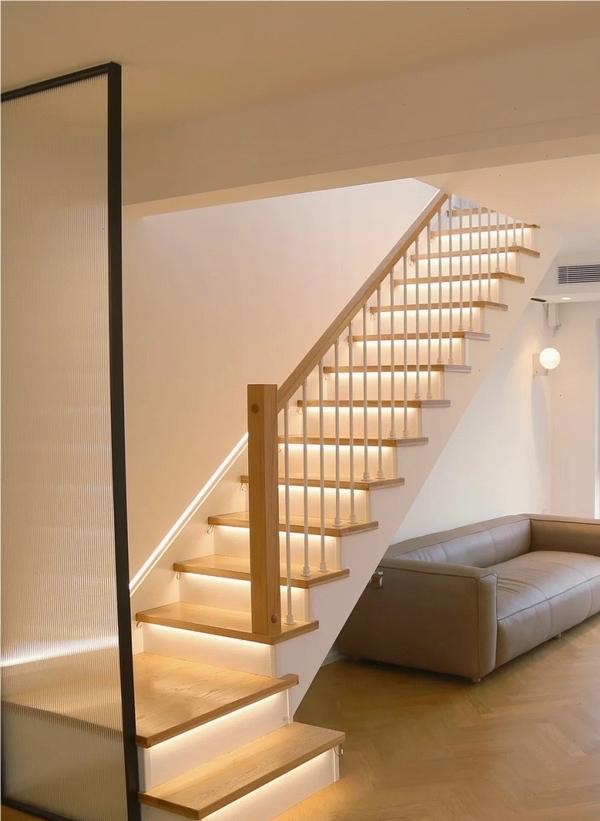
In Summary
LED strip lights for staircases do more than improve visibility; they add a touch of elegance to your area. Several methods exist to install these lights, whether through clips, aluminum channels, or adhesive strips.
When selecting LED strips for your stairs, prioritizing quality is essential. MylikeLed has got you covered in this regard. We provide an extensive range of LED strips perfect for staircase illumination. Plus, we offer personalized solutions upon request. Don’t hesitate! Reach out to us and elevate your stair lighting TODAY!
FAQs
Installing LED strip lights on stairs improves both safety and aesthetics. These lights help illuminate each step, reducing the risk of tripping—especially at night. They also add a stylish, modern look to your staircase, making it a design feature in your home or business.
The best place to install LED strip lights on stairs is under the lip of each tread (stair edge) or along the side railing or wall. Installing them under each step provides even lighting and a clean look, while side installations can add a soft ambient glow.
Yes, LED strip lights are safe for stair installation when installed correctly. Make sure they are securely attached, use proper voltage, and connect to a reliable power source. Also, consider using water-resistant LED strips for extra protection in humid or outdoor areas.
Yes, you need a compatible power supply for your LED strip lights on stairs. The power supply should match the voltage (e.g., 12V or 24V) and support the total wattage of your LED strip length. Always calculate the total power needed before choosing the adapter.
Yes, LED stair lights are dimmable when paired with a compatible dimmer switch or controller. You can even use smart controllers or motion sensors to automatically adjust the brightness, depending on time of day or movement.
For stair lighting, choose flexible LED strips with good brightness (measured in lumens) and an appropriate color temperature. Warm white (2700K–3000K) gives a cozy feel, while cool white (4000K–6000K) offers a clean and modern look. Waterproof strips are best for outdoor stairs or humid areas.

Hi, I’m Xylia Xiong, a sales professional with 14 years of experience in the LED strip light industry. I specialize in providing tailored solutions, leveraging my expertise in LED products and the latest industry trends. Known for effective communication and problem-solving, I’m dedicated to helping lighting manufacturers, importers, and distributors achieve their goals.
Let’s work together to create customized solutions that exceed expectations.
Related Posts

The Best LED Strip Lights You Can Buy Right Now

Comparing WS2811 Vs WS2812B: Key Differences


